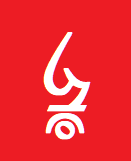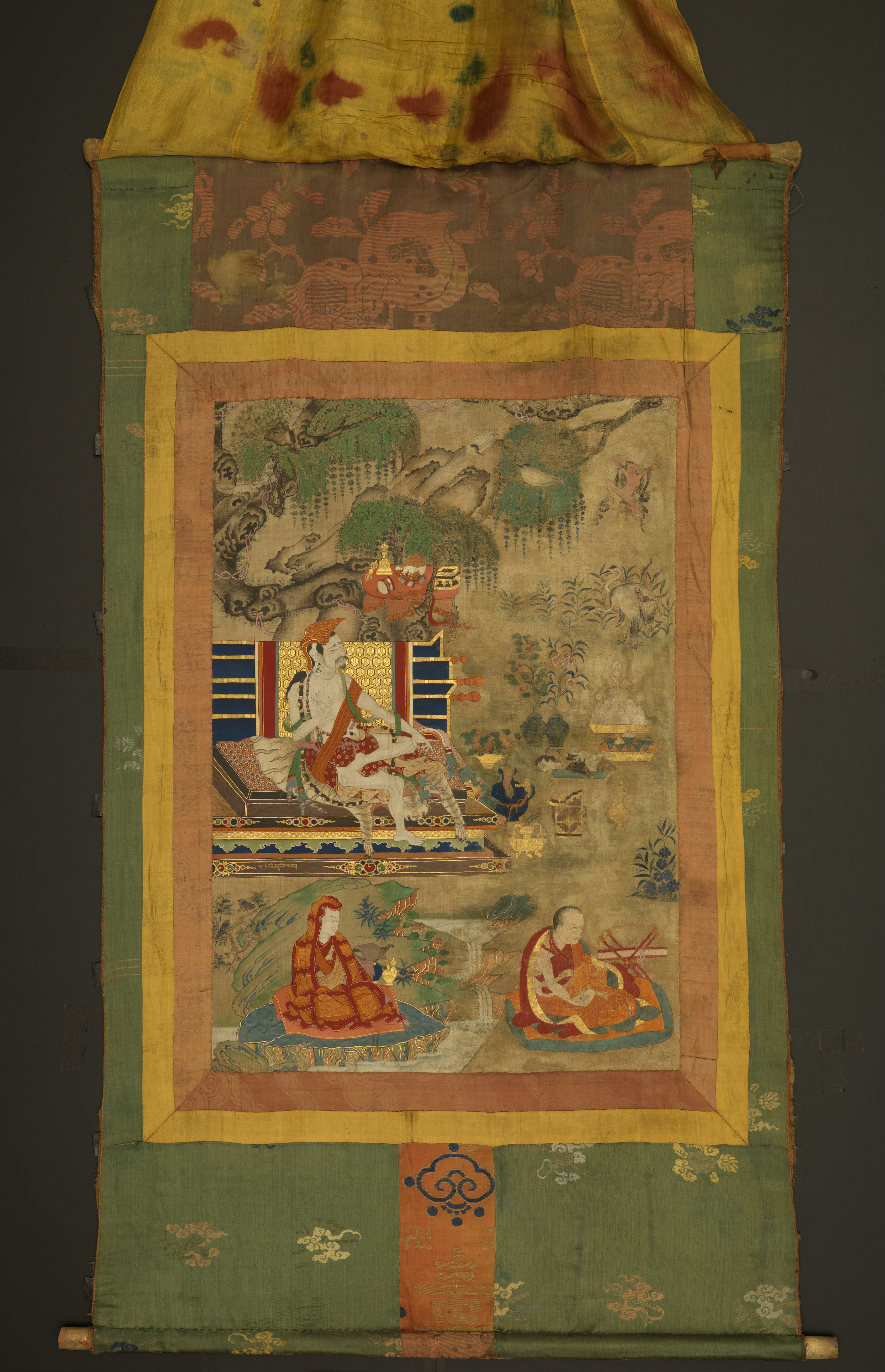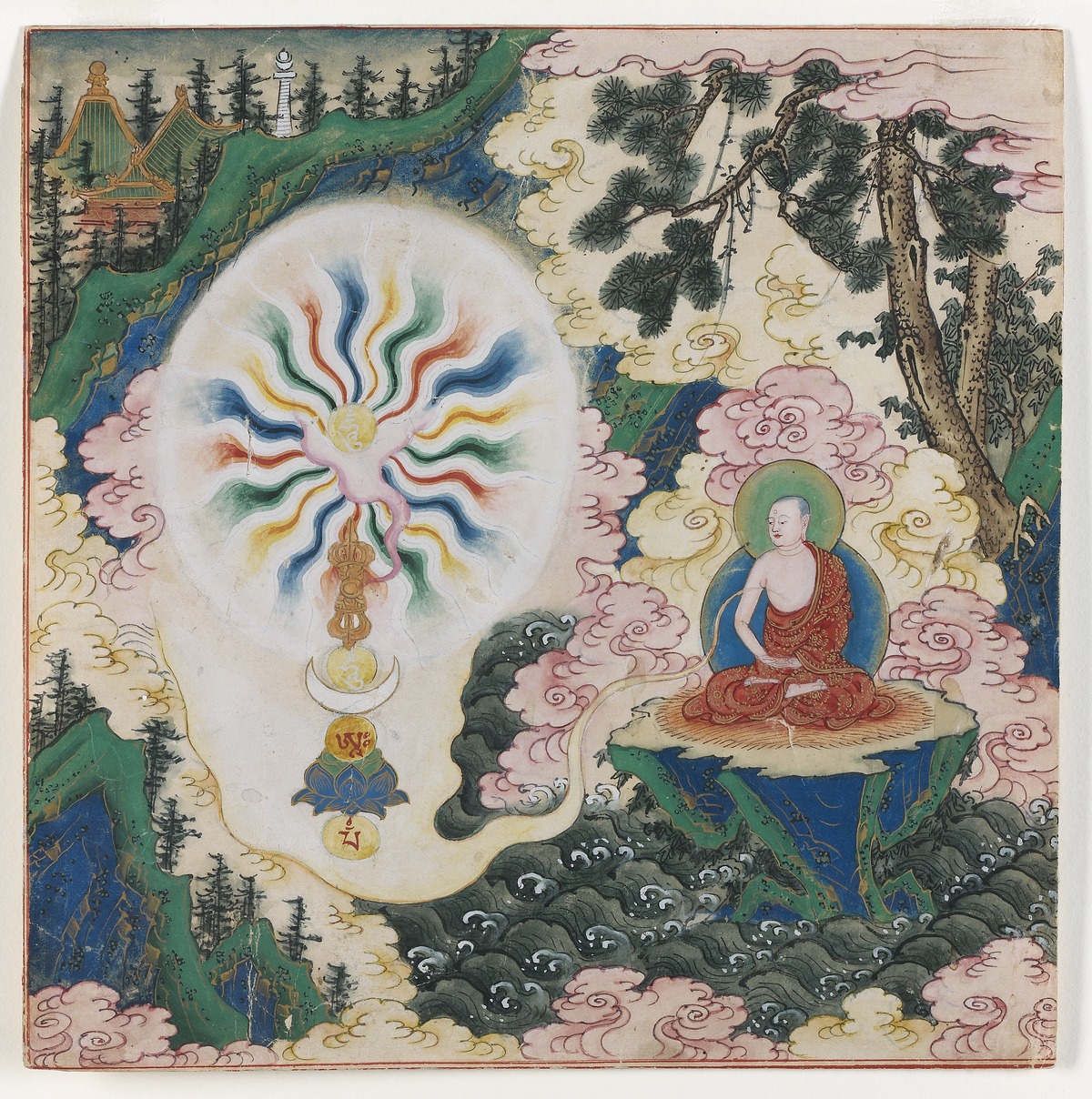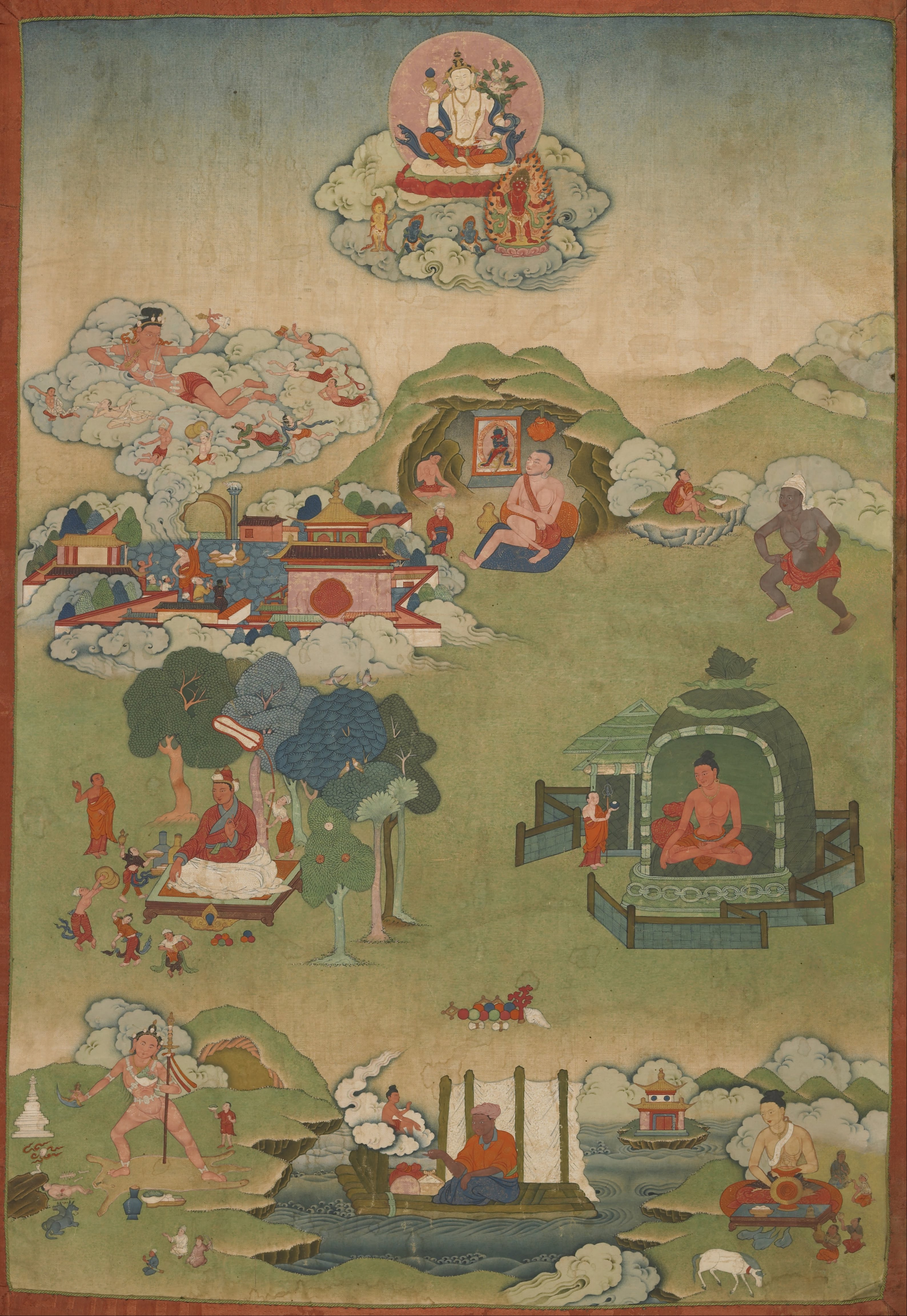|
Tummo
In Tibetan Buddhism, ''tummo'' (; sa, चण्डाली, caṇḍālī) is the fierce goddess of heat and passion. Tummo is found in the Mahasiddha Krishnacarya and the '' Hevajra Tantra'' texts. Tummo is also a tantric practice for inner heat, developed around the concept of the female deity. It is found in the Six Dharmas of Naropa, Lamdre, Kalachakra. and Anuyoga teachings of Vajrayana. The purpose of tummo is to gain control over body processes during the completion stage of 'highest yoga tantra' (Anuttarayoga Tantra) or Anuyoga. Etymology ''Tummo'' (''gTum mo'' in Wylie transliteration, also spelled ''tumo'', or ''tum-mo''; Sanskrit ' or ''chandali'') is a Tibetan word, literally meaning 'fierce oman. ''Tummo'' is also the Tibetan word for 'inner fire.' ''Tummo'' may also be rendered in English approximating its phonemic pronunciation as ''dumo''. Practice Inner heat (''gtum mo'', skt. ''chandali,'' literally meaning "fierce, hot or savage woman") practice is t ... [...More Info...] [...Related Items...] OR: [Wikipedia] [Google] [Baidu] |
Six Dharmas Of Naropa
The Six Dharmas of Nāropa (, Skt. ''ṣaḍdharma'', "Naro's six doctrines" or "six teachings"), are a set of advanced Tibetan Buddhist tantric practices compiled by the Indian mahasiddhas Tilopa and Nāropa (1016-1100 CE) and passed on to the Tibetan translator-yogi Marpa Lotsawa (c. 1012). Another name for the six Dharmas is "the oral instruction transmission for achieving liberation in the bardo," or "the ''Bardo Trang-dol'' system". Bardo here, refers to the three bardos of waking, sleep and dying. They are also referred to as "the path of means" (''thabs lam'') in Kagyu literature.Kragh (2015), p. 345. They are also sometimes called the ''Six Yogas of Nāropa'' (though not in the traditional literature which never uses the term ''ṣaḍaṅga-yoga'' or ''sbyor-drug''). The six dharmas are a collection of tantric Buddhist completion stage practices drawn from the Buddhist tantras. They are intended to lead to Buddhahood in an accelerated manner. They traditionally re ... [...More Info...] [...Related Items...] OR: [Wikipedia] [Google] [Baidu] |
Completion Stage
The fundamental practice of Vajrayana and Tibetan tantra is deity yoga (''devatayoga''), meditation on a chosen deity or "cherished divinity" (Skt. ''Iṣṭa-devatā,'' Tib. ''yidam''), which involves the recitation of mantras, prayers and visualization of the deity, the associated mandala of the deity's Buddha field, along with consorts and attendant Buddhas and bodhisattvas. According to the Tibetan scholar Tsongkhapa, deity yoga is what separates Tantra from Sutra practice. In the Unsurpassed Yoga Tantras, the most widespread tantric form in Indo-Tibetan Buddhism, this method is divided into two stages, the generation stage (''utpatti-krama'') and the completion stage (''nispanna-krama''). In the generation stage, one dissolves one's reality into emptiness and meditates on the deity-mandala, resulting in identification with this divine reality. In the completion stage, the divine image along with the subtle body is applied to the realization of luminous emptiness. The Indi ... [...More Info...] [...Related Items...] OR: [Wikipedia] [Google] [Baidu] |
Vajrayana
Vajrayāna ( sa, वज्रयान, "thunderbolt vehicle", "diamond vehicle", or "indestructible vehicle"), along with Mantrayāna, Guhyamantrayāna, Tantrayāna, Secret Mantra, Tantric Buddhism, and Esoteric Buddhism, are names referring to Buddhist traditions associated with Tantra and "Secret Mantra", which developed in the medieval Indian subcontinent and spread to Tibet, Nepal, other Himalayan states, East Asia, and Mongolia. Vajrayāna practices are connected to specific lineages in Buddhism, through the teachings of lineage holders. Others might generally refer to texts as the Buddhist Tantras. It includes practices that make use of mantras, dharanis, mudras, mandalas and the visualization of deities and Buddhas. Traditional Vajrayāna sources say that the tantras and the lineage of Vajrayāna were taught by Śākyamuni Buddha and other figures such as the bodhisattva Vajrapani and Padmasambhava. Contemporary historians of Buddhist studies meanwhile argue t ... [...More Info...] [...Related Items...] OR: [Wikipedia] [Google] [Baidu] |
Tibetan Tantric Practice
Tibetan tantric practice, also known as "the practice of secret mantra", and "tantric techniques", refers to the main tantric practices in Tibetan Buddhism. The great Rime scholar Jamgön Kongtrül refers to this as "the Process of Meditation in the Indestructible Way of Secret Mantra" and also as "the way of mantra," "way of method" and "the secret way" in his ''Treasury of Knowledge''. These Vajrayāna Buddhist practices are mainly drawn from the Buddhist tantras and are generally not found in "common" (i.e. non-tantric) Mahayana. These practices are seen by Tibetan Buddhists as the fastest and most powerful path to Buddhahood. In Tibetan Buddhism, the higher tantric yogas are generally preceded by preliminary practices ( Tib. '' ngondro''), which include sutrayana practices (i.e. non-tantric Mahayana practices) as well as preliminary tantric meditations. Tantric initiation is required to enter into the practice of tantra. '' Unsurpassable Yoga Tantra'', (Skt. ''anuttarayog ... [...More Info...] [...Related Items...] OR: [Wikipedia] [Google] [Baidu] |
Kalachakra
''Kālacakra'' () is a polysemic term in Vajrayana Buddhism that means " wheel of time" or "time cycles". "''Kālacakra''" is also the name of a series of Buddhist texts and a major practice lineage in Indian Buddhism and Tibetan Buddhism. The tantra is considered to belong to the unexcelled yoga ('' anuttara-yoga'') class. Kālacakra also refers both to a patron tantric deity or yidam in Vajrayana and to the philosophies and yogas of the Kālacakra tradition. The tradition's origins are in India and its most active later history and presence has been in Tibet. The tradition contains teachings on cosmology, theology, philosophy, sociology, soteriology, myth, prophecy, medicine and yoga. It depicts a mythic reality whereby cosmic and socio-historical events correspond to processes in the bodies of individuals. These teachings are meant to lead to a transformation of one's body and mind into perfect Buddhahood through various yogic methods. The Kālacakra tradition is based o ... [...More Info...] [...Related Items...] OR: [Wikipedia] [Google] [Baidu] |
Lung (Tibetan Buddhism)
Lung ( ''rlung'') means wind or breath. It is a key concept in the Vajrayana traditions of Tibetan Buddhism and has a variety of meanings. ''Lung'' is a concept that is particularly important to understandings of the subtle body and the trikaya (body, speech and mind). Traditional Tibetan medicine practitioner Dr. Tamdin Sither Bradley provides a summary: Usages Some of the different usages of the term ''lung'' include: * the psychic winds (sanskrit: ''prana'') that travel in the internal channels, or ''nadi'' (Sanskrit) of the subtle body and are manipulated in certain Vajrayana yoga practices. * specifically the five psychic winds that are a manifestation of the mahābhūta. These five are the lifeforce that animate the bodymind (Sanskrit: ''namarupa'') of all sentient beings and are key to certain tantric Buddhist and Bon sādhanās and traditional Tibetan medicine. * to the vayu and prana of ayurveda. * as a component of the term for a type of prayer flag, named after the ... [...More Info...] [...Related Items...] OR: [Wikipedia] [Google] [Baidu] |
Tibetan Buddhism
Tibetan Buddhism (also referred to as Indo-Tibetan Buddhism, Lamaism, Lamaistic Buddhism, Himalayan Buddhism, and Northern Buddhism) is the form of Buddhism practiced in Tibet and Bhutan, where it is the dominant religion. It is also in majority regions surrounding the Himalayan areas of India (such as Ladakh, Sikkim, Arunachal Pradesh, and a minority in Himachal Pradesh and Uttarakhand), in much of Central Asia, in the southern Siberian regions such as Tuva, and in Mongolia. Tibetan Buddhism evolved as a form of Mahāyāna Buddhism stemming from the latest stages of Indian Buddhism (which also included many Vajrayāna elements). It thus preserves many Indian Buddhist tantric practices of the post-Gupta early medieval period (500 to 1200 CE), along with numerous native Tibetan developments. In the pre-modern era, Tibetan Buddhism spread outside of Tibet primarily due to the influence of the Mongol Yuan dynasty (1271–1368), founded by Kublai Khan, which had rul ... [...More Info...] [...Related Items...] OR: [Wikipedia] [Google] [Baidu] |
Gampopa
Gampopa Sönam Rinchen (, 1079–1153) was the main student of Milarepa, and a Tibetan Buddhist master who codified his own master's ascetic teachings, which form the foundation of the Kagyu educational tradition. Gampopa was also a doctor and tantric master. He authored the first Lamrim text, '' Jewel Ornament of Liberation,'' and founded the Dagpo Kagyu school. He is also known as Dvagpopa, and by the titles ''Dakpo Lharjé'' "the physician from Dakpo" () and ''Daö Zhönnu'', "''Candraprabhakumara''" (). Biography Gampopa was born in the Nyal (or Nyel) district, Central Tibet and from an early age was a student of medicine in the Indian, Chinese and Tibetan medical traditions. Later in his life he moved to the region of Dakpo (''dwags po'') in southern Tibet and hence was also called Dakpopa (''dwags po pa''), the man from Dakpo. The region is also near Gampo Hills, hence his other name, Gampopa. In his youth Gampopa studied under the Nyingma lama Barey as well as under ... [...More Info...] [...Related Items...] OR: [Wikipedia] [Google] [Baidu] |
Mahamudra
Mahāmudrā (Sanskrit: महामुद्रा, , contraction of ) literally means "great seal" or "great imprint" and refers to the fact that "all phenomena inevitably are stamped by the fact of wisdom and emptiness inseparable". Mahāmudrā is a multivalent term of great importance in later Indian Buddhism and Tibetan Buddhism which "also occurs occasionally in Hindu and East Asian Buddhist esotericism." The name also refers to a body of teachings representing the culmination of all the practices of the Sarma schools of Tibetan Buddhism, who believe it to be the quintessential message of all of their sacred texts. The ''mudra'' portion denotes that in an adept's experience of reality, each phenomenon appears vividly, and the ''maha'' portion refers to the fact that it is beyond concept, imagination, and projection. Reginald Ray, ''Secret of the Vajra World''. Shambhala 2001, page 261. The practice of Mahāmudrā is also known as the teaching called " Sahajayoga" or "Co- ... [...More Info...] [...Related Items...] OR: [Wikipedia] [Google] [Baidu] |
Enlightenment In Buddhism
The English term enlightenment is the Western translation of various Buddhist terms, most notably bodhi and vimutti. The abstract noun ''bodhi'' (; Sanskrit: बोधि; Pali: ''bodhi''), means the knowledge or wisdom, or awakened intellect, of a Buddha. The verbal root ''budh-'' means "to awaken," and its literal meaning is closer to awakening. Although the term '' buddhi'' is also used in other Indian philosophies and traditions, its most common usage is in the context of Buddhism. ''Vimukti'' is the freedom from or release of the fetters and hindrances. The term "enlightenment" was popularised in the Western world through the 19th-century translations of German-born philologist Max Müller. It has the Western connotation of general insight into transcendental truth or reality. The term is also being used to translate several other Buddhist terms and concepts, which are used to denote (initial) insight ('' prajna'' (Sanskrit), '' wu'' (Chinese), '' kensho'' and ''satori' ... [...More Info...] [...Related Items...] OR: [Wikipedia] [Google] [Baidu] |
Tsongkhapa
Tsongkhapa ('','' meaning: "the man from Tsongkha" or "the Man from Onion Valley", c. 1357–1419) was an influential Tibetan Buddhist monk, philosopher and tantric yogi, whose activities led to the formation of the Gelug school of Tibetan Buddhism.Tsong khapa (2006), pp. ix-x. He is also known by his ordained name Losang Drakpa (, Skt. Sumatikīrti) or simply as "Je Rinpoche" (, "Precious Lord"). He is also known by Chinese as Zongkapa Lobsang Zhaba or just Zōngkàbā (宗喀巴). Tsongkhapa was born in Amdo, the son of a Tibetan Longben Tribal leader who also once served as an official of the Yuan Dynasty. As a monk, he studied under numerous teachers of the various Tibetan Buddhist traditions which flourished in central Tibet, including Sakya, Jonang, Kagyu and Kadam. Tsongkhapa was a prolific author with a broad knowledge of Buddhist philosophy, logic, hermeneutics and practice. He wrote numerous works on madhyamaka philosophy (such as ''Ocean of Reasoning,'' a ... [...More Info...] [...Related Items...] OR: [Wikipedia] [Google] [Baidu] |



_(8697431158).jpg)


.jpeg/1200px-Tibetan_Buddhism_(214837929).jpeg)
.jpg)